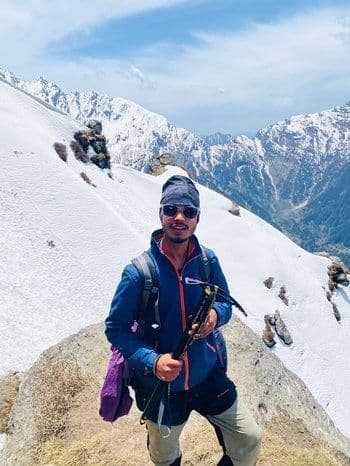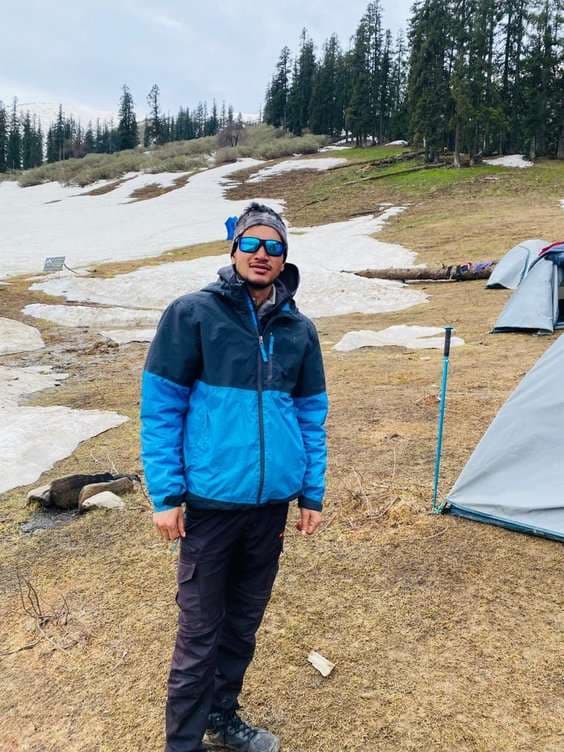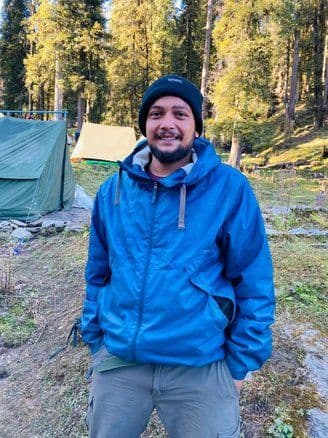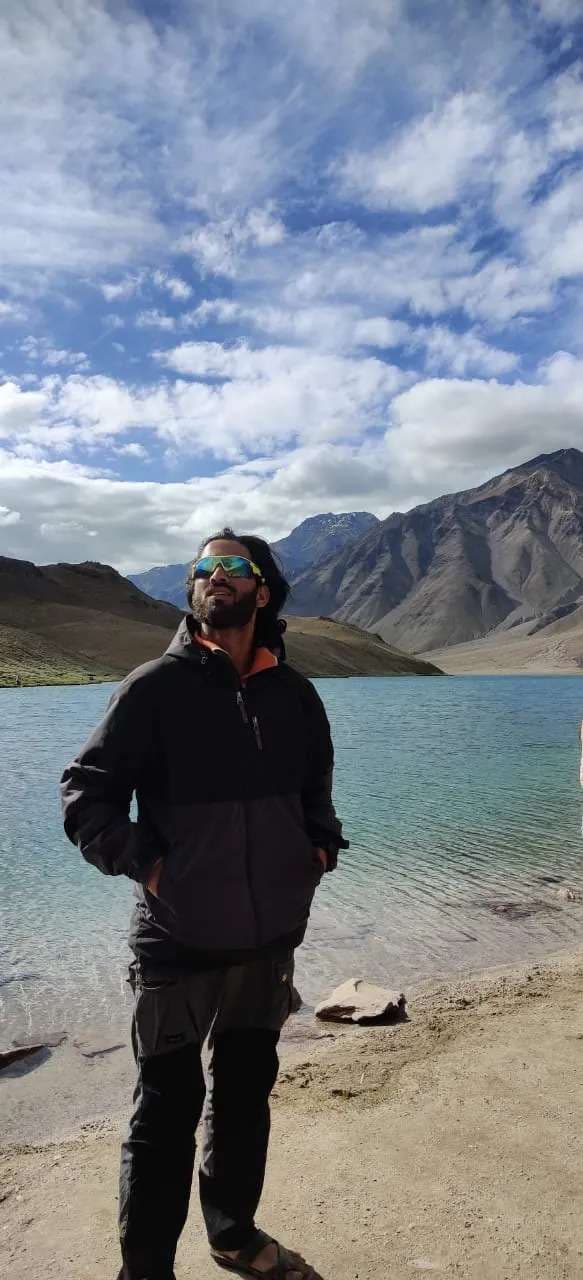Chaukhamba II, also referred to as Chaukhamba II Peak, stands as one of the prominent summits in the Garhwal Himalayas of Uttarakhand, India. It forms an integral part of the Chaukhamba Massif, encompassing several peaks within its range. Positioned within the Garhwal region of Uttarakhand, India, Chaukhamba II is nestled amidst the Gangotri Group of peaks. Its location places it in proximity to the sacred town of Badrinath, and it is encompassed by the Chamoli district. Chaukhamba II elevates to an impressive height of approximately 7,070 meters (23,196 feet) above sea level.
Chaukhamba II boasts a history of challenging ascents, drawing the attention of mountaineers and climbers from diverse corners of the globe. The inaugural successful ascent of first climbed by an Indian team in the year 1967.Subsequently, numerous climbing teams have achieved successful ascents, navigating its technical and demanding terrain.
Typical routes for ascending Chaukhamba II encompass a blend of ice, snow, and technical climbing elements, with the northwest ridge emerging as a well-traveled pathway to the summit. Climbers confronting Chaukhamba II often encounter technical complexities and the unpredictable challenges of high-altitude weather conditions during their ascent.
Chaukhamba II, along with its neighboring peaks, holds a deep cultural and spiritual significance within the cultural tapestry of India. The Garhwal region, where it is situated, is renowned for its revered temples and pilgrimage sites.
Ascending Chaukhamba II necessitates meticulous planning and technical competence due to its formidable altitude and the rigorous terrain it presents. Climbers must embark on their ascent well-prepared and adequately acclimatized to the high-altitude environment.
The entire Garhwal region, inclusive of Chaukhamba II, falls within the boundaries of the Nanda Devi Biosphere Reserve, a protected natural area. Conservation endeavors are diligently executed to safeguard the unique flora and fauna indigenous to this region.
Chaukhamba II remains a compelling attraction for mountaineers and climbers, offering an enticing blend of adventure and natural grandeur. Nevertheless, scaling this peak calls for meticulous planning, a mastery of technical skills, and unwavering respect for the surrounding environment.
Chaukhamba II, also referred to as Chaukhamba II Peak, stands as one of the prominent summits in the Garhwal Himalayas of Uttarakhand, India. It forms an integral part of the Chaukhamba Massif, encompassing several peaks within its range. Positioned within the Garhwal region of Uttarakhand, India, Chaukhamba II is nestled amidst the Gangotri Group of peaks. Its location places it in proximity to the sacred town of Badrinath, and it is encompassed by the Chamoli district. Chaukhamba II elevates to an impressive height of approximately 7,070 meters (23,196 feet) above sea level.
Chaukhamba II boasts a history of challenging ascents, drawing the attention of mountaineers and climbers from diverse corners of the globe. The inaugural successful ascent of first climbed by an Indian team in the year 1967.Subsequently, numerous climbing teams have achieved successful ascents, navigating its technical and demanding terrain.
Typical routes for ascending Chaukhamba II encompass a blend of ice, snow, and technical climbing elements, with the northwest ridge emerging as a well-traveled pathway to the summit. Climbers confronting Chaukhamba II often encounter technical complexities and the unpredictable challenges of high-altitude weather conditions during their ascent.
Chaukhamba II, along with its neighboring peaks, holds a deep cultural and spiritual significance within the cultural tapestry of India. The Garhwal region, where it is situated, is renowned for its revered temples and pilgrimage sites.
Ascending Chaukhamba II necessitates meticulous planning and technical competence due to its formidable altitude and the rigorous terrain it presents. Climbers must embark on their ascent well-prepared and adequately acclimatized to the high-altitude environment.
The entire Garhwal region, inclusive of Chaukhamba II, falls within the boundaries of the Nanda Devi Biosphere Reserve, a protected natural area. Conservation endeavors are diligently executed to safeguard the unique flora and fauna indigenous to this region.
Chaukhamba II remains a compelling attraction for mountaineers and climbers, offering an enticing blend of adventure and natural grandeur. Nevertheless, scaling this peak calls for meticulous planning, a mastery of technical skills, and unwavering respect for the surrounding environment.
Best time for Chaukhamba II Expedition
The best time to attempt an expedition to Chaukhamba II, located in the Garhwal region of Uttarakhand, India, largely depends on the weather and climbing conditions. The most suitable time for a Chaukhamba II expedition is typically during the pre-monsoon season and post-monsoon season. Here are the best times to plan your expedition:
1. Pre-Monsoon Season (Late April to Early June):
Late April to early June is considered the pre-monsoon season in the Garhwal Himalayas.
This period is ideal for Chaukhamba II expeditions as the weather is relatively stable, and the mountain is usually less prone to heavy snowfall and avalanches.
The days are longer, providing more daylight hours for climbing.
Temperatures are milder, but it can still be quite cold at higher altitudes.
2. Post-Monsoon Season (Late September to October):
The post-monsoon season, from late September to October, is another suitable window for Chaukhamba II expeditions.
After the monsoon rains, the skies tend to clear up, and the weather stabilizes.
The mountain is less likely to be covered in heavy snow, making climbing conditions more manageable.
The fall season offers crisp and clear views of the surrounding landscapes.
It's essential to note that Chaukhamba II is a high-altitude peak with challenging climbing routes. Regardless of the season chosen for your expedition, you must be well-prepared for cold temperatures, high-altitude acclimatization, and technical climbing challenges. Additionally, always check the weather forecasts and current climbing conditions before undertaking your expedition to ensure safety.
Keep in mind that while these are the most favorable seasons for Chaukhamba I expeditions, mountaineering in the Himalayas is inherently risky, and weather conditions can change rapidly. Therefore, it's crucial to consult with experienced guides, obtain the necessary permits, and make safety a top priority throughout your expedition.
How to reach Dehradun
Dehradun, the capital city of the Indian state of Uttarakhand, is well-connected by various modes of transportation. Here are several ways to reach Dehradun:
1. By Air:
Jolly Grant Airport (Dehradun Airport): The nearest airport to Dehradun is Jolly Grant Airport, which is approximately 30 kilometers (18.6 miles) away from the city center. It offers domestic flights from major cities in India, including Delhi, Mumbai, and Bangalore. Once you arrive at the airport, you can hire a taxi or take a pre-paid taxi to reach Dehradun city.
2. By Train:
Dehradun has its railway station, Dehradun Railway Station (station code: DDN). It is well-connected to several major cities in India, including Delhi, Mumbai, Kolkata, and Chennai. You can check the train schedules and book tickets through the Indian Railways website or at railway station counters.
3. By Road:
Bus: Dehradun has a well-developed road network, and you can reach the city by bus. There are regular bus services from nearby cities and states, including Delhi, Chandigarh, and Haridwar. State-run and private bus operators provide these services.
Self-Drive: If you prefer to drive, you can reach Dehradun by road. The city is well-connected to major highways, and the journey can be a scenic one. Ensure that you have a valid driving license and check the road conditions before your trip.
4. By Taxi/Car Rental:
You can hire a taxi or opt for a car rental service to reach Dehradun from nearby cities or airports. This option provides flexibility in terms of travel timings and stops along the way.
5. By Train and Bus Combination:
Depending on your location, you might consider taking a train to a nearby city like Haridwar or Rishikesh and then continuing your journey to Dehradun by bus or taxi.
6. By Air and Taxi Combination:
If you're traveling from a city without direct flights to Dehradun, you can consider taking a flight to Delhi or another nearby major airport and then booking a domestic flight to Dehradun. From the Dehradun Airport, you can hire a taxi to reach the city center.
Before you travel, it's advisable to check the availability and schedules of transportation options, especially if you have specific arrival and departure times. Additionally, make sure to book your accommodations in Dehradun in advance, especially if you're arriving during the peak tourist season.
Things to carry for Chaukhamba II Expedition
Climbing Chaukhamba II, a challenging peak in the Garhwal Himalayas of Uttarakhand, India, requires careful preparation and the right gear. Here is a list of essential items to carry for a Chaukhamba II expedition:
Climbing Gear:
1. Climbing Boots: Sturdy, insulated, and suitable for high-altitude mountaineering.
2. Crampons: With anti-balling plates.
3. Ice Axe: Suitable for both self-arrest and technical ice climbing.
4. Climbing Harness: Comfortable and adjustable.
5. Helmet: To protect against falling ice and rock.
6. Belay Device: For rope management and rappelling.
7. Carabiners: Locking and non-locking carabiners for various uses.
8. Ascender: For rope ascension if needed.
9. Prusik Cord: For ascending ropes.
10. Slings and Webbing: For anchors and safety.
Ropes and Cordage:
11. Climbing Ropes: Dynamic ropes suitable for mountaineering.
12. Static Ropes: For glacier travel and rappelling.
13. Cordage: For various applications, such as building anchors and rescue.
Protection and Anchors:
14. Snow Pickets or Deadman Anchors: For creating anchors in snow and ice.
15. Ice Screws: For protection in ice.
16. Snow Flukes: Snow anchors for soft snow conditions.
Clothing:
17. Base Layers: Moisture-wicking and thermal layers.
18. Insulation Layers: Down or synthetic jacket for cold conditions.
19. Waterproof Shell Jacket and Pants: Gore-Tex or similar materials.
20. Climbing Pants: Durable and weather-resistant.
21. Gaiters: To keep snow and debris out of your boots.
22. Mountaineering Gloves: Waterproof and insulated.
23. Liner Gloves: Thin gloves for dexterity.
24. Balaclava or Neck Gaiter: To protect against cold and wind.
25. Warm Hat: Wool or fleece.
26. Sunglasses: Category 3 or 4 for high-altitude sun protection.
27. Goggles: With UV protection for snow and high winds.
28. Socks: Wool or synthetic, suitable for layering.
29. Overboots: To add insulation and protection to your climbing boots.
Backpack and Carrying Gear:
30. Expedition Backpack: Large capacity with gear loops.
31. Daypack: For summit pushes.
32. Climbing Harness: To carry essentials.
33. Crampon Bag: To protect your pack from crampon points.
34. Gear Sling or Gear Loops: To organize gear on your harness.
35. Sled or Pulk (if needed): For hauling gear on glaciers.
Camping and Shelter:
36. Four-Season Tent: Designed for high-altitude use.
37. Sleeping Bag: Rated for extreme cold.
38. Sleeping Pad: Insulated for warmth.
39. Stove and Fuel: For cooking at higher camps.
40. Cookware: Lightweight and suitable for high-altitude cooking.
41. Food and Nutrition: High-energy, dehydrated meals.
42. Water Filtration or Purification: To melt snow and ice for drinking water.
43. Headlamp: With extra batteries.
Safety and Navigation:
44. Map and Compass: For navigation.
45. GPS Device: Optional for navigation and tracking.
46. Altitude Meter or Watch: To monitor elevation.
47. First Aid Kit: Comprehensive for high-altitude emergencies.
48. Climbing Helmet: Required for safety.
49. Avalanche Safety Gear (if applicable): Transceiver, probe, and shovel.
50. Satellite Phone or Communication Device: For emergency contact.
51. Repair Kit: For equipment repairs.
Personal Items:
52. Identification and Documentation: Passport, permits, and emergency contacts.
53. Cash: For unforeseen expenses.
54. Toiletries: Minimal essentials.
55. Medications: Personal prescriptions and altitude sickness medications.
56. Sunscreen and Lip Balm: High SPF for sun protection.
57. Personal Hygiene Items: Toothbrush, toilet paper, etc.
58. Camera and Electronics: Optional for documenting the expedition.
Miscellaneous:
59. Trash Bags: For waste disposal and Leave No Trace principles.
60. Duct Tape: For gear repairs.
61. Repair Kit: For equipment maintenance.
62. Snow Shovel: For campsite preparation.
Ensure that you pack all necessary gear and double-check the condition of your equipment before departing for the expedition. Climbing Chaukhamba II is a challenging endeavor, and having the right gear can significantly contribute to your safety and success.
How to prepare for Chaukhamba II Expedition
Preparing for a Chaukhamba II expedition, a challenging peak in the Garhwal Himalayas, requires careful planning, physical fitness, and technical skills. Here is a step-by-step guide on how to prepare for this high-altitude mountaineering expedition:
1. Gain Mountaineering Experience:
Prioritize building a strong foundation of mountaineering experience on less challenging peaks and technical routes.
Gain proficiency in ice and rock climbing, glacier travel, and crevasse rescue techniques.
2. Physical Fitness:
Focus on comprehensive physical fitness, including cardiovascular endurance, strength, and stamina.
Incorporate aerobic activities like running, hiking, and cycling into your training regimen.
Strength training exercises for the core, legs, and upper body are crucial for carrying heavy loads and using climbing gear.
3. Altitude Acclimatization:
Develop an acclimatization schedule to adapt to high-altitude conditions. Spend time at progressively higher altitudes before the expedition.
Practice good altitude hygiene by staying hydrated and ascending gradually.
4. Technical Skills:
Hone your technical climbing skills, including the use of ice axes, crampons, ropes, harnesses, and helmets.
Familiarize yourself with rope work, belaying, and crevasse rescue techniques.
5. Gear Familiarization:
Acquire high-quality mountaineering gear and become familiar with its use. This includes boots, crampons, ice axes, harnesses, helmets, ropes, and technical climbing gear.
6. High-Altitude Training:
If possible, participate in high-altitude training programs or climbing clinics to prepare specifically for the challenges of high-altitude mountaineering.
7. Join an Experienced Team:
Consider joining a guided expedition led by experienced leaders and guides who are familiar with Chaukhamba I and its challenges.
A skilled team can provide valuable guidance, logistics support, and safety measures.
8. Research the Route:
Study the climbing route, potential hazards, and logistics of the expedition. Understand the approach, campsites, and technical sections.
9. Weather and Conditions:
Familiarize yourself with the weather patterns in the region and be prepared for rapid weather changes at high altitudes.
Check current climbing conditions and forecasts before starting the expedition.
10. Physical and Mental Preparation:
Mentally prepare yourself for the physical and mental challenges of high-altitude climbing.
Develop a strong mindset for resilience and decision-making in challenging situations.
11. Emergency Response Plan:
Create a comprehensive emergency response plan for medical issues or rescue situations.
Ensure you have access to communication devices like satellite phones or emergency locator beacons.
12. Permits and Documentation:
Obtain all necessary permits and permissions from the Indian Mountaineering Foundation (IMF) or relevant authorities.
Ensure your passport, visas, and other documents are in order.
13. Expedition Planning:
Plan the logistics of the expedition, including transportation, accommodations, and food provisions.
14. Leave No Trace:
Practice Leave No Trace principles to minimize your environmental impact in the mountains.
Dispose of waste properly, including human waste, using established procedures for high-altitude areas.
15. Final Gear Check:
Perform a thorough gear check to ensure everything is in working order before departing for the expedition.
16. Safety First:
Always prioritize safety over summit objectives. Be willing to turn back if conditions become unsafe or if any team member is experiencing health issues.
Chaukhamba I is a demanding peak that requires excellent physical fitness, technical proficiency, and careful planning. Seek guidance from experienced climbers or guides, and prioritize safety throughout your preparation and expedition.
Safety factors for Chaukhamba II Expedition
Safety is of paramount importance when embarking on a Chaukhamba II expedition or any high-altitude mountaineering endeavor. Here are crucial safety factors to consider for your Chaukhamba II Expedition:
1. Experienced Guides and Team:
Partner with experienced guides and a well-trained expedition team with a proven track record of successful high-altitude climbs.
Ensure that all team members are knowledgeable about mountain safety and emergency procedures.
2. Acclimatization:
Follow a gradual acclimatization schedule to allow your body to adjust to higher altitudes, reducing the risk of altitude sickness.
Schedule rest days at different altitude levels to aid acclimatization.
3. Weather Monitoring:
Stay updated on weather forecasts for the region and be prepared for rapidly changing weather conditions at high altitudes.
Make well-informed decisions based on weather reports, and be ready to adjust your plans accordingly.
4. Emergency Communication:
Carry reliable communication devices such as satellite phones or emergency locator beacons (ELBs) to call for help in case of emergencies.
Ensure that someone at your base camp or a designated contact knows your itinerary and can raise an alarm if needed.
5. Avalanche Awareness:
If you're climbing in an area prone to avalanches, equip yourself with avalanche safety gear, including transceivers, probes, and shovels.
Learn avalanche safety protocols and terrain assessment techniques.
6. Health and Fitness:
Ensure that all team members are in good physical health and adequately trained for high-altitude climbing.
Monitor each team member's condition for symptoms of altitude sickness, frostbite, or other health issues.
7. Rope Team and Safety Gear:
Use appropriate rope teams with experienced leaders and roped travel in glacier areas.
Carry necessary safety gear like snow pickets, ice screws, and anchors for crevasse rescue and securing your team.
8. Emergency Evacuation Plan:
Develop a clear and well-rehearsed plan for emergency evacuations, including helicopter rescue options if available.
Ensure that all team members are aware of the plan and their roles in an emergency.
9. First Aid and Medical Supplies:
Carry a comprehensive first aid kit and medical supplies for treating common mountain-related injuries and illnesses.
Train team members in basic wilderness first aid.
10. Climbing Permits and Documentation:
Obtain all necessary climbing permits and have your documentation in order.
Follow local regulations and respect the environment.
11. Leave No Trace:
Practice Leave No Trace principles to minimize your environmental impact. Dispose of waste properly, including human waste, using established procedures for high-altitude areas.
12. Decision-Making and Turnaround Time:
Establish a turnaround time for reaching the summit, and adhere to it strictly.
Encourage a culture of open communication and the ability to turn back if conditions become unsafe.
13. Experience and Training:
Ensure that all team members have the necessary experience and training for high-altitude mountaineering and technical climbing.
14. Mutual Support:
Foster a culture of teamwork and mutual support within the expedition team.
Look out for the physical and mental well-being of your fellow climbers.
15. Emergency Shelter:
Carry emergency shelters like bivouac sacks or tents in case you need to wait out adverse conditions.
16. Respect Local Customs and Environment:
Respect local customs and the natural environment. Engage with local communities in a culturally sensitive manner.
Safety should always be the top priority during a Chaukhamba II expedition. Be prepared to make conservative decisions and turn back if conditions or health concerns arise. A successful expedition is one where everyone returns safely, regardless of whether the summit is reached.











